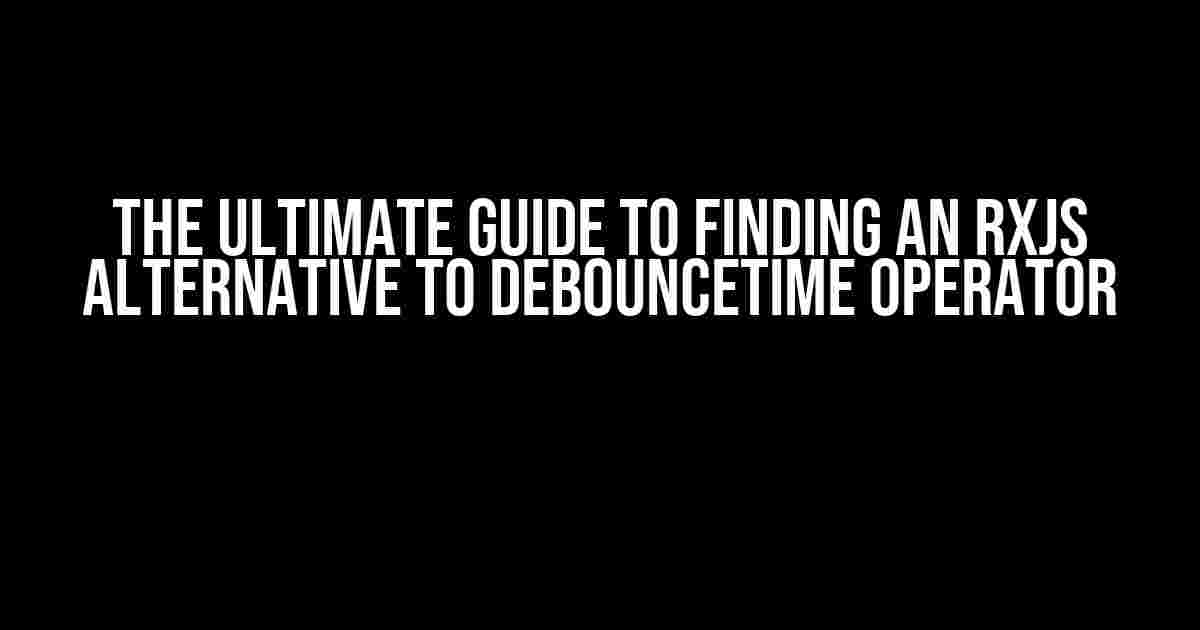Are you tired of dealing with the limitations of the debounceTime operator in RxJS? Do you find yourself stuck with items getting collected and affecting your application’s performance? Worry no more! In this comprehensive guide, we’ll explore alternative solutions to debounceTime operator and show you how to keep those items from getting collected.
What’s Wrong with DebounceTime Operator?
The debounceTime operator is a popular choice among RxJS developers for handling rapid-fire events, such as key presses or mouse clicks. However, it has its drawbacks. One major issue is that it collects items during the debounce period, which can lead to:
- Memory leaks
- Performance issues
- Unwanted behavior in your application
So, what can you do instead? Let’s dive into some RxJS alternative solutions that’ll keep those items from getting collected.
Alternative 1: AuditTime Operator
The auditTime operator is a lesser-known but powerful alternative to debounceTime. It works by emitting the most recent value in the source Observable after a specified time span, ignoring all other values in between.
import { interval, auditTime } from 'rxjs';
const source = interval(100); // emit 0, 1, 2, 3, ...
const auditedSource = source.pipe(auditTime(500));
auditedSource.subscribe(val => console.log(`Audit Time: ${val}`));
In this example, the auditTime operator will only emit the most recent value every 500 milliseconds, discarding all other values in between.
When to Use AuditTime Operator
The auditTime operator is ideal for scenarios where you want to:
- Reduce the frequency of events
- Ignore rapid-fire events
- Sample the most recent value in a stream
Alternative 2: ThrottleTime Operator
The throttleTime operator is another popular alternative to debounceTime. It works by emitting the first value in the source Observable and then ignoring all other values for a specified time span.
import { interval, throttleTime } from 'rxjs';
const source = interval(100); // emit 0, 1, 2, 3, ...
const throttledSource = source.pipe(throttleTime(500));
throttledSource.subscribe(val => console.log(`Throttle Time: ${val}`));
In this example, the throttleTime operator will only emit the first value every 500 milliseconds, discarding all other values in between.
When to Use ThrottleTime Operator
The throttleTime operator is suitable for scenarios where you want to:
- Limit the rate of events
- Prevent rapid-fire events from overwhelming your application
- Guarantee a minimum time span between events
Alternative 3: SampleTime Operator
The sampleTime operator is another alternative to debounceTime, which works by emitting the most recent value in the source Observable at a specified time interval.
import { interval, sampleTime } from 'rxjs';
const source = interval(100); // emit 0, 1, 2, 3, ...
const sampledSource = source.pipe(sampleTime(500));
sampledSource.subscribe(val => console.log(`Sample Time: ${val}`));
In this example, the sampleTime operator will only emit the most recent value every 500 milliseconds, discarding all other values in between.
When to Use SampleTime Operator
The sampleTime operator is ideal for scenarios where you want to:
- Periodically sample the latest value in a stream
- Reduce the frequency of events
- Guarantee a consistent time span between events
Comparison of RxJS Alternatives to DebounceTime Operator
In this table, we’ll compare the three RxJS alternatives to debounceTime operator:
| Operator | Description | Use Cases |
|---|---|---|
| AuditTime | Emit the most recent value after a time span | Reduce frequency, ignore rapid-fire events, sample latest value |
| ThrottleTime | Emit the first value and ignore others for a time span | Limit rate, prevent rapid-fire events, guarantee time span |
| SampleTime | Emit the most recent value at a specified time interval | Periodically sample latest value, reduce frequency, guarantee time span |
Each of these operators has its strengths and weaknesses, and the right choice depends on your specific use case.
Conclusion
In this article, we’ve explored three RxJS alternatives to debounceTime operator that can help you avoid item collection and improve your application’s performance. Remember to choose the right operator based on your specific use case and requirements.
By using auditTime, throttleTime, or sampleTime operators, you can:
- Reduce memory leaks
- Improve performance
- Enhance your application’s overall user experience
So, the next time you’re faced with the limitations of debounceTime operator, consider using one of these alternatives to keep those items from getting collected.
Happy coding!
Frequently Asked Question
Unravel the mysteries of RxJS and find out how to avoid collecting items with these expert-approved questions and answers!
What is the RxJS alternative to debounceTime operator?
A popular alternative is the throttleTime operator! It’s similar to debounceTime, but it emits the first value immediately and then ignores subsequent values for the specified time period.
Why do items get collected with debounceTime?
DebounceTime collects items because it buffers the emissions from the source observable and only releases them when the specified time period has passed without any new emissions. This means that if new values are emitted during the debounce period, they’ll be added to the buffer, causing the previous values to be collected.
How can I prevent items from getting collected with debounceTime?
You can use the asyncScheduler or any other scheduler to schedule the emission of the values, effectively preventing the collection of items. Alternatively, you can use the throttleTime operator, which doesn’t buffer values and thus won’t collect them.
What’s the difference between throttleTime and debounceTime?
ThrottleTime emits the first value immediately, then ignores subsequent values for the specified time period. DebounceTime, on the other hand, ignores all values until the specified time period has passed without any new emissions, and then emits the latest value. This means throttleTime is more suitable for situations where you want to emit values at a fixed rate, while debounceTime is better suited for situations where you want to wait for a period of inactivity before emitting a value.
Can I use debounceTime with other RxJS operators to achieve the desired behavior?
Yes, you can combine debounceTime with other operators to achieve the desired behavior. For example, you can use debounceTime with the switchMap operator to cancel any pending requests and only process the latest value.


